Your First Brokerage Account, Done in 15 Minutes
(and the one hour of prep that makes it easy)
Last Reviewed: August 10, 2025
Open a brokerage account fast with this 15-minute guide and one hour of prep.
If you want to open a brokerage account fast but the process feels like a pop quiz, you’re not alone. I froze at “investment objective” too. This guide skips the jargon and gets you from nervous to invested in 15 minutes. This guide shows you how to open a brokerage account fast with a clear 7 step sprint.
Disclaimer: This guide is U.S.-focused. Rules and account types can differ in other countries.
Who is this for? (and who it’s not for)
- ✅ For: First-time U.S. investors who want a safe, simple start using broad index funds.
- ❌ Not for: Active trading, options, short-term strategies, or anyone needing personalized advice.
What you will get: In 15 minutes, you’ll have an open account, a funded transfer, and a first-buy plan on autopilot. 📈
What you won’t get: Stock tips, leverage tricks, or hype.
Table of Contents
- Quick Take & why it matters
- PRINT & KEEP: One-Page Checklist
- How to Use This Guide
- Plain-English Glossary & ACH timing
- Your Road Map to Opening an Account
- Stop 1: The Why and the What
- Stop 2: The Where – Choosing Your Brokerage
- Stop 3: The 15-Minute Sprint – Application & Funding
- Stop 4: Your First Investment – A Simple, Strong Start
- Beginner Mistakes to Calmly Avoid
- Edge-Case FAQs
- About the Author, Disclosures, & Methodology
Quick Take: open a brokerage account fast
- Goal → Account: Retirement? 👉 IRA. A goal 5-10 years away? 👉 Taxable account. Picking the right container avoids tax headaches later.
- Beginner Setting: Always choose a Cash account, not Margin. This removes the number one source of regret: borrowing to invest.
- Docs Ready: Have your SSN, Government ID, Address, Employment Info, and Basic Financials ready. This turns the application into a sprint.
- Simple Start: Buy the haystack, not the needle. A mix of U.S. stock, International stock, and U.S. bond index funds provides instant diversification.
- Safety Net: SIPC insurance protects your account for up to $500k ($250k in cash) if your broker fails. It does not cover market losses.
PRINT & KEEP: One-Page Checklist
I turned this guide into a one-page checklist you can print and use while opening your account.
➡️ Download the Open a Brokerage Account Fast checklist (PDF): https://www.dropbox.com/scl/fi/gjo3vtq6yq6b9ny35qb00/open-brokerage-checklist.pdf?rlkey=3vla6duhikgihu30o3c8fsgka&st=9owgtgfj&dl=0
How to Use This Guide to Open a Brokerage Account Fast.
We’ll do about one hour of prep work that makes the actual application a 15-minute sprint. Then, we’ll start investing with a simple, diversified plan you can stick with. If you searched how to open a brokerage account fast, you’re in the right place.
Glossary
- ACH: A standard electronic transfer from your bank to your brokerage.
- Expense Ratio: The tiny annual fee a fund charges. An expense ratio of 0.03% is just $3 per year for every $10,000 invested.
- Index Fund / ETF: A basket of investments that tracks a market (like the S&P 500), removing the need for stock picking.
- Margin: Borrowing money from your broker to invest. It increases risk and can force you to sell at the worst time.
- Rebalance: Nudging your investment mix back to your original targets, usually once a year.
- SIPC: The Securities Investor Protection Corporation. It safeguards your assets if a brokerage firm fails, but not from market ups and downs.
How long does an ACH transfer take?
ACH bank transfers usually settle in 1 to 2 business days. Weekends and bank holidays don’t count. First-time or large transfers can sometimes take 3 to 5 business days, and the funds might appear as “pending” before you can invest them.
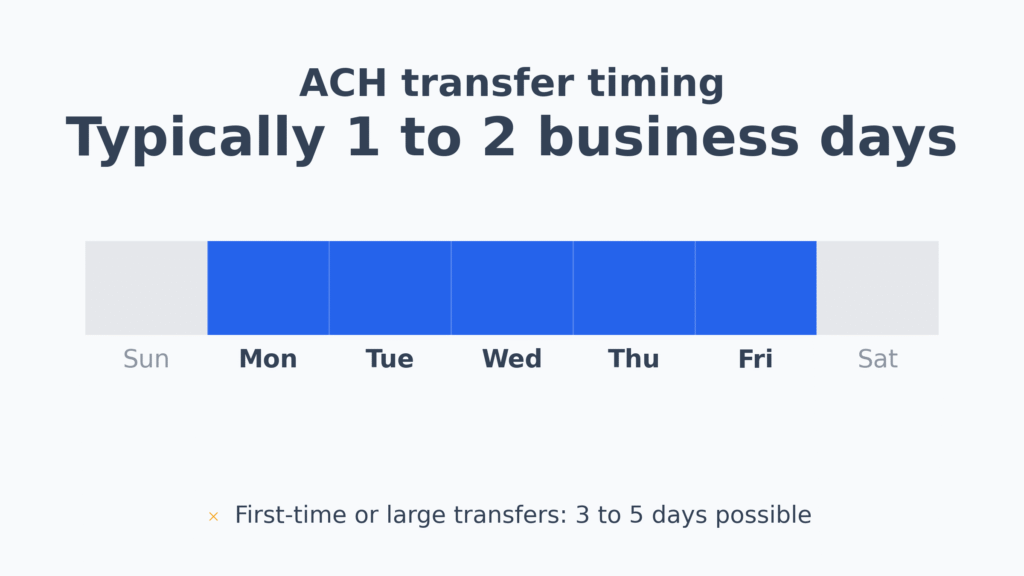
Road Map: Open a Brokerage Account Fast.
- The Why and What: Match your goal to the right account type.
- The Where: Choose a reliable brokerage.
- The 15-Minute Sprint: Complete the application and fund the account.
- Your First Investment: Use a boringly effective starter strategy.
Stop 1: The Why and the What
Your “Why” Makes Everything Else Easy
Think of investment accounts like luggage. You pack differently for a weekend beach trip than for a two-week ski trip. Get your “why” right first, and the rest becomes obvious.
Fast Decision Path
- Retirement in 20-40 years? ➡️ IRA.
- Choose a Roth IRA if you expect to be in a higher tax bracket in retirement.
- Choose a Traditional IRA if you expect to be in a lower tax bracket.
- House or car in 5-10 years? ➡️ Taxable brokerage account.
- Might need the money in < 3 years? ➡️ Cash or other low-risk vehicles. Investing in stocks may not be appropriate for short-term goals.
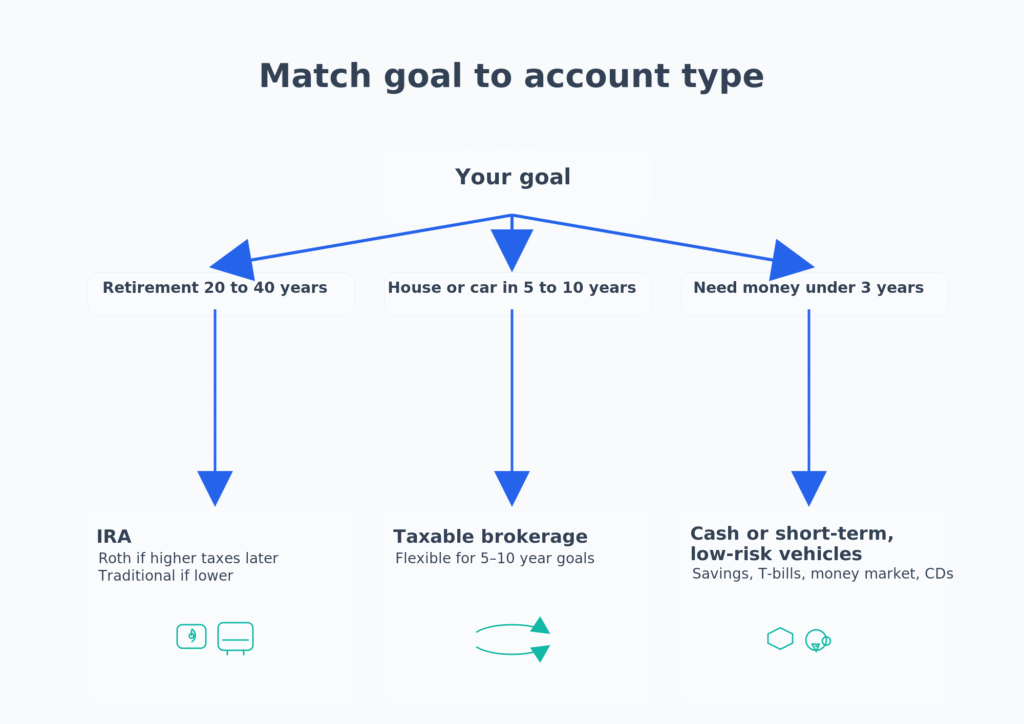
Taxable vs. IRA
- Taxable Brokerage (Non-Retirement): Maximum flexibility. You can add or withdraw money anytime (though taxes may apply to gains). Great for goals 5-10 years out.
- IRA (Retirement Only): A locked treasure chest for Future-You. It offers powerful tax advantages for long-term growth.
- Roth IRA: You contribute with after-tax dollars. Qualified withdrawals in retirement can be tax-free.
- Traditional IRA: Contributions may be tax-deductible now. Withdrawals are taxed as income in retirement.
Bottom Line: Need flexibility? 👉 Taxable. Saving for retirement? 👉 IRA. (Tax rules can change. Always check the current year’s IRS page before you contribute.)
Cash vs. Margin: The Easiest Beginner Decision
- Cash Account: Like a debit card. You can only invest the money you deposit. It’s simple and safe.
- Margin Account: Lets you borrow money from the broker to invest. This amplifies both gains and losses.
For beginners, the choice is simple: Pick Cash.
What Could Go Wrong?
- Using margin and being forced to sell your investments during a market downturn.
- Putting money you’ll need within 3 years into volatile assets like stocks.
- Panic-selling after a normal market correction.
- Ignoring taxes and paying more than you need to.
Myth vs. Fact
- Myth: You need a lot of money to start.
- Fact: Fractional shares let you start with as little as $25.
- Myth: SIPC covers my investment losses.
- Fact: SIPC only covers broker failure, not market movements.
- Myth: Margin is the best way to boost returns.
- Fact: Margin can magnify losses and force you to sell at a loss.
- Myth: Picking a few great stocks will beat index funds.
- Fact: Broad, low-cost funds let you own all the winners without having to guess which ones they’ll be.
Stop 2: The Where – Choosing Your Brokerage
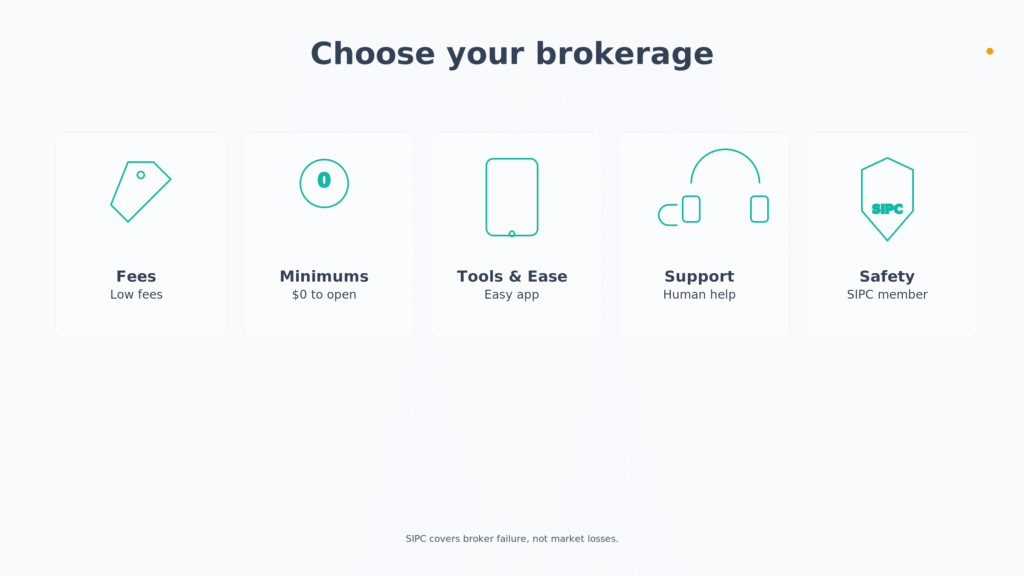
Practical Checklist
- Fees: Look for $0 commissions on stock and ETF trades and low expense ratios on funds.
- Account Minimums: A $0 minimum to open is ideal for beginners.
- Tools & Ease of Use: The app should be simple and intuitive. You don’t need pro-level charts yet.
- Support: Can you reach a real human by phone or chat if you get stuck?
- Transparency: The broker should be a registered SIPC member with clear disclosures.
If two options seem close, pick the one you’ll actually use.
Deal-Breakers (Skip the broker if you see these)
- 🚫 SIPC membership is unclear or missing.
- 🚫 No fractional shares (this makes it hard to invest small amounts).
- 🚫 High or hard-to-find ACATS transfer-out fees.
- 🚫 Your target index funds are not available commission-free.
- 🚫 No clear option to automatically reinvest dividends (DRIP).
Nice-to-haves: Instant ACH deposits, a clean mobile app, and weekend support. Note: You can always transfer your account to another broker later via an ACATS transfer. Just ask about the transfer-out fee before you open an account.
STOP 3: How to Open a Brokerage Account Fast — Application & Funding
Open a brokerage account fast: the 7-step sprint
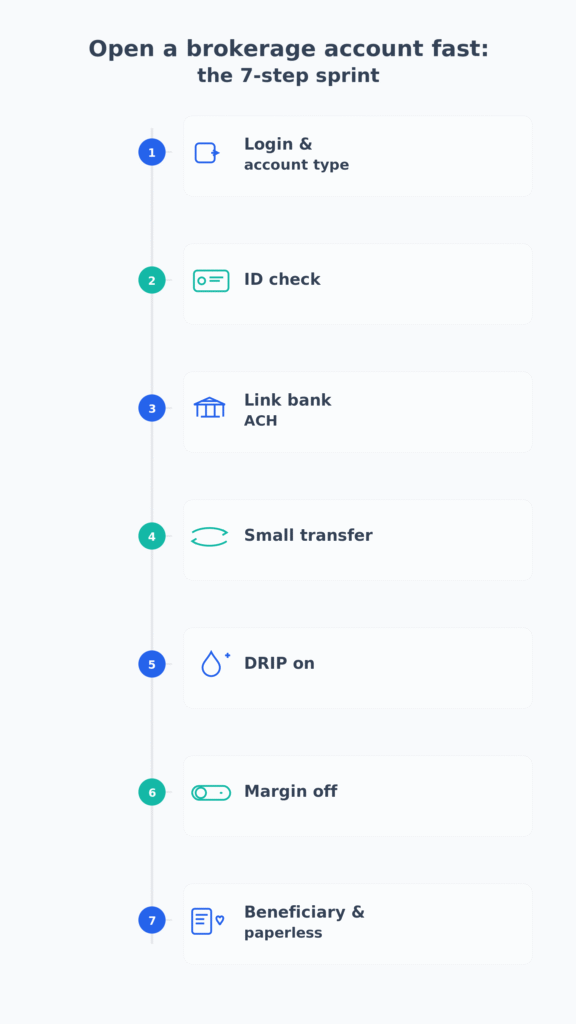
What You’ll Need (Gather These First)
- Social Security Number (SSN)
- Government-issued ID (Driver’s License, Passport)
- Permanent address
- Employment status & basic financial info (income/net worth ranges)
Copy below plan to open a brokerage account fast—then walk through each step.
How to open a brokerage account fast with this guide
- Create your login. Choose your account: Taxable, Roth IRA, or Traditional IRA. Select Cash Account.
- Verify your identity. Enter your SSN, ID details, and address.
- Link your bank account via ACH.
- Start a small transfer ($50 is fine) to test the connection.
- Turn ON dividend reinvestment (DRIP). This automatically buys more shares with the dividends your investments pay out.
- Turn OFF margin, options, and day-trading permissions. You can revisit these later if needed.
- Add a beneficiary and set up paperless statements.
Tip: If you searched “open a brokerage account fast,” this is your exact checklist. Copy it, then do it.
Stop 4: Your First Investment – A Simple, Strong Start
I wanted a strategy I could actually stick to. Here is the “buy the haystack” plan:
- U.S. Total Stock Market fund (your core holding)
- International Total Stock Market fund (for global diversification)
- U.S. Total Bond Market fund (for stability)
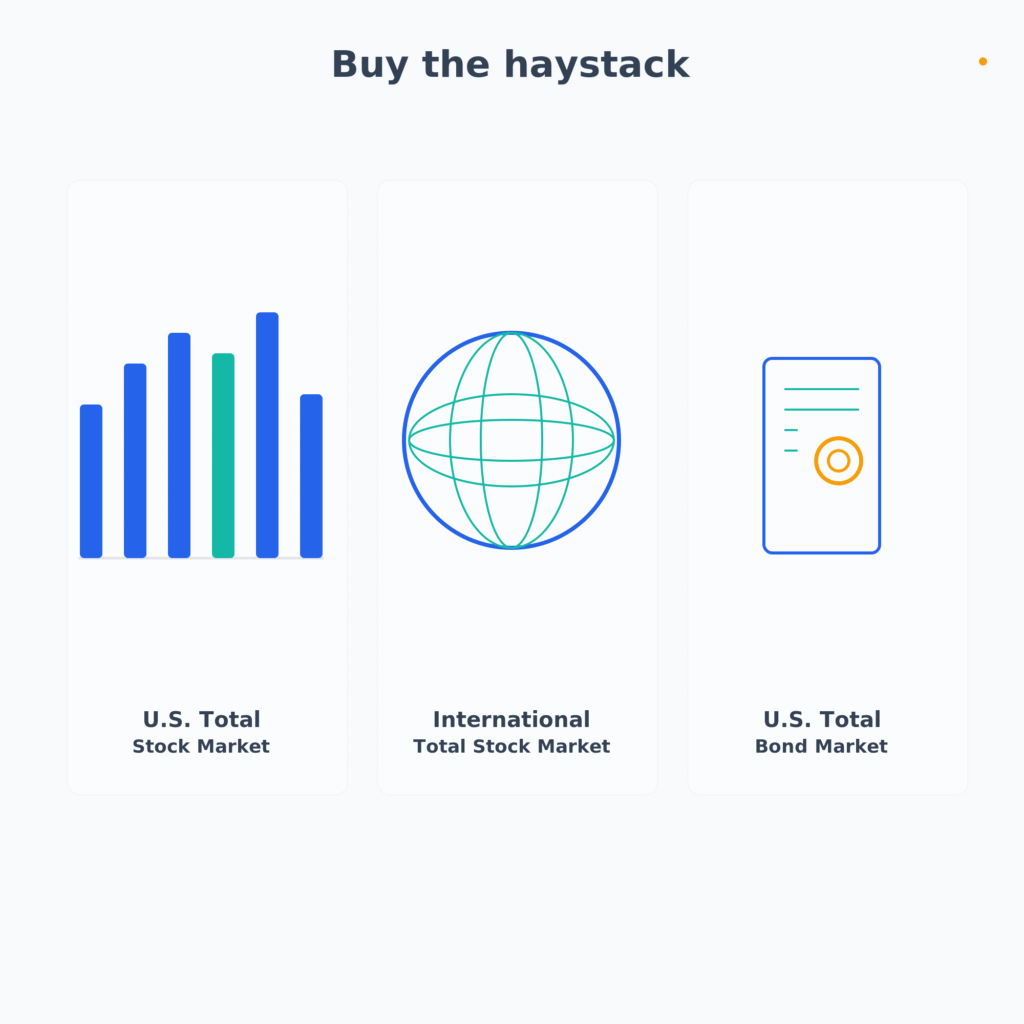
Placing Your First Order: 30-Second Script
- Search for your fund’s ticker symbol (e.g., VTI).
- Order Type: Market is fine for small, long-term buys. (Use a Limit order if you want to set a specific price).
- Quantity: Enter a dollar amount (for fractional shares) or a number of shares.
- Timing: During market hours is simplest.
- Tap Buy and confirm. That’s it!
Your 3-Fund Starter Pack (by Broker)
Here are popular, low-cost ETF options at major brokerages.
- Vanguard:
- U.S. Stock: VTI
- International Stock: VXUS
- U.S. Bond: BND
- Fidelity:
- U.S. Stock: ITOT
- International Stock: IXUS
- U.S. Bond: AGG
- Schwab:
- U.S. Stock: SCHB
- International Stock: SCHF
- U.S. Bond: SCHZ
Note: This is for educational purposes, not advice. Always check the current expense ratios and trading costs before buying.
Example Allocations (For Education Only)
- 15+ Year Timeline: 80% Stocks / 20% Bonds
- 5-10 Year Timeline: 60% Stocks / 40% Bonds
- “Sleep-Well” Option: 50% Stocks / 50% Bonds
Rebalance once a year. As your goal gets closer, increase your allocation to bonds.
Cost Translator: Fees in Plain Dollars
An expense ratio of 0.03% costs you just $3 per year for every $10,000 you have invested. Tiny fees matter over decades.
Your 30-60-90 Day Stick-With-It Plan
- Day 1-30: Automate your deposits. Make one small buy to get started.
- Day 31-60: Read your plan once. Change nothing.
- Day 61-90: Confirm your automation is running. Schedule your once-a-year rebalance in your calendar.
The $5 Test
Make a single $5 purchase of your chosen fund today. It’s not about the amount; it’s about breaking the inertia. Then, turn on a small weekly auto-deposit.
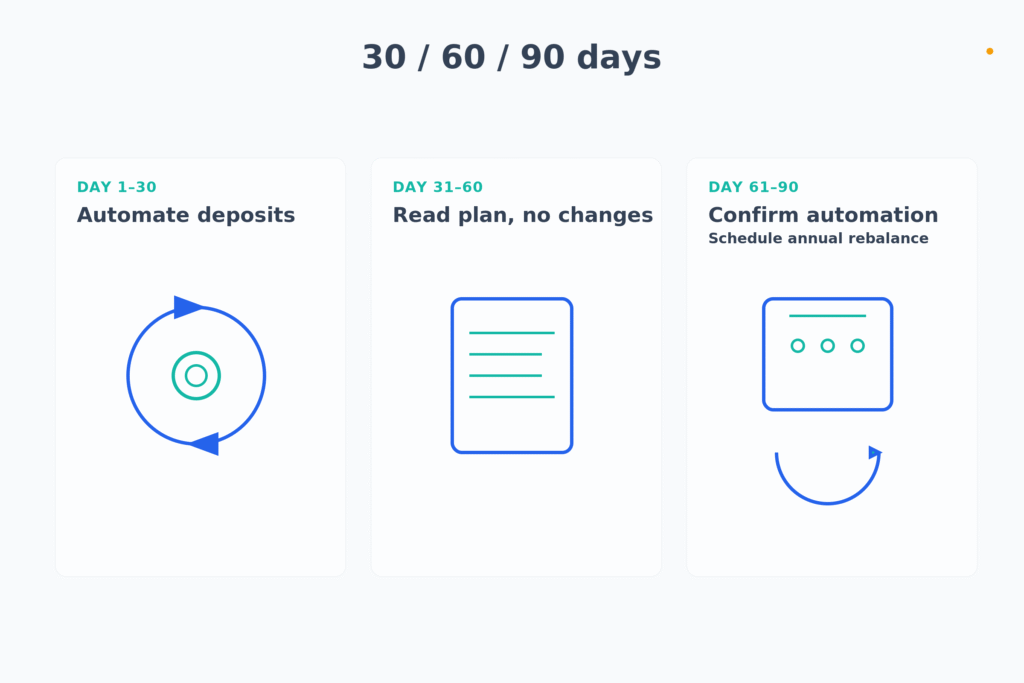
Beginner Mistakes to Avoid When You Open a Brokerage Account Fast
- 🚫 Jumping to margin before you understand the risks.
- 🚫 Stock picking first instead of learning with low-cost index funds.
- 🚫 Letting cash pile up unintentionally. Set up automation.
- 🚫 Chasing hot tips instead of following your written plan.
- 🚫 Ignoring account types (IRA vs. Taxable) and their tax implications.
One-Page Printable Checklist (for your Snapshot)
Prep (60 min)
- [ ] Define goal: Retirement → IRA or 5-10 yr goal → Taxable
- [ ] Choose Cash, not Margin
- [ ] Pick broker (check fees, ease of use, support, SIPC status)
- [ ] Gather docs: SSN, ID, Address, Employment info
Application (15 min)
- [ ] Create account (Taxable, Roth IRA, or Traditional IRA)
- [ ] Review disclosures & verify identity
- [ ] Link bank via ACH and start a transfer
First Investment (10 min)
- [ ] Choose tickers from your broker’s lineup
- [ ] Place a small test buy
- [ ] Automate future deposits (e.g., weekly)
Stay on Track
- [ ] Rebalance annually
- [ ] Re-read your written plan before making any changes
- [ ] Avoid margin and hot tips
With the prep done and a simple first buy, you can open a brokerage account fast and start investing on autopilot. Bookmark this guide and the checklist so your next account takes even less time.
FAQs
Q: Can non-citizens open a U.S. brokerage account? A: Sometimes. Policies vary by firm. You will usually need a U.S. address and tax forms like the W-8BEN. Check the broker’s eligibility page before you apply.
Q: Can I open an account with an ITIN instead of an SSN? A: Some brokers accept an ITIN, but many do not. Confirm the broker’s policy before starting the application.
Q: How do I open an investment account for a minor? A: Look into custodial accounts like an UGMA or UTMA. If the child has earned income, a custodial Roth IRA may be possible.
Q: I have a 401(k) match. Should I still open a separate brokerage? A: Many people capture their full employer match first, as it’s free money. A separate brokerage account can then be used for goals your 401(k) doesn’t cover. This is educational info, not personal advice.
Q: Can I transfer my account to another broker later? A: Yes. Most U.S. brokers support ACATS transfers. Ask about any transfer-out fee before you open the account.
Q: What documents do I need to open a brokerage account? A: You will usually need your SSN or ITIN, a government-issued ID, your permanent address, employment status, and basic financial information (income/net worth).
About the Author
Investi-Buddy is a fellow beginner who documents everything he is learning. He turns expert-speak into simple, safe, actionable steps. No affiliates and no hype. Just careful research, plain English, and habits that compound.
Disclosures, Safety Notes and Methodology
- Education only. I am not your advisor, and this is not personal financial, tax, or legal advice.
- Risk. All investing involves risk, including the possible loss of principal.
- SIPC. Protects against brokerage failure up to $500,000 total ($250,000 for cash). It does not protect against market loss.
- Methodology. I verify terms and definitions with primary sources, avoid affiliate links, and keep an update log below.
Update Log
- 2025-08-10: First publication. Glossary near the top, broker deal-breakers, 30-60-90 plan, myth vs fact, 5 Dollar test, expanded FAQ, ACH micro-answer, and image plan inserted.
Master Reference List
- DALBAR. (2024). 2024 QAIB: Quantitative analysis of investor behavior. DALBAR, Inc.
- Board of Governors of the Federal Reserve System. (2021). The retail investor revolution. FEDS Notes.
- Financial Industry Regulatory Authority (FINRA). (n.d.). FINRA Rule 2090: Know your customer.
- Internal Revenue Service. (2023, November 1). 401(k) limit increases to $23,000 for 2024, IRA limit rises to $7,000.
- Securities Investor Protection Corporation (SIPC). (n.d.). What SIPC protects.